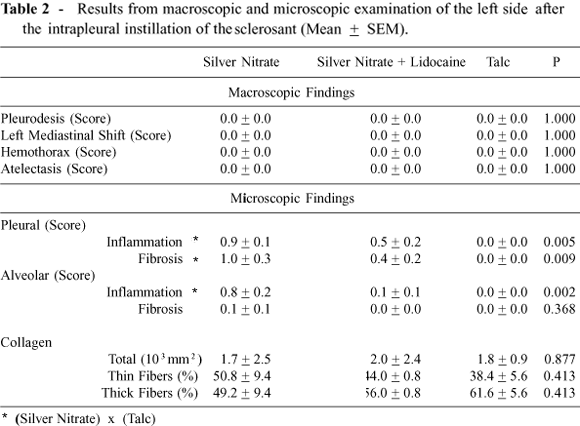The ideal agent for producing pleurodesis has not been identified. Talc, the most commonly used, poses several problems. Another possibility is silver nitrate, which was widely used in the past. PURPOSE: To determine the influence of the intrapleural instillation of lidocaine in producing a pleurodesis with silver nitrate, to define the effect of lidocaine in the maturation of the collagen fibers, and to confirm that the pleurodesis after silver nitrate is stronger than after talc. METHODS: We studied three groups of 8 rabbits. Two groups received 0.5% silver nitrate; in one we had previously injected 0.5 ml of 2% lidocaine. The third group received 400 mg/kg talc (2 ml). The animals were sacrificed 28 days after the injection, and the pleural spaces were assessed grossly for evidence of pleurodesis and microscopically for evidence of inflammation and fibrosis. The total amount of pleural collagen and the distribution of thick and thin collagen fibers were quantified. Collagen was identified using picrosirius red stain. RESULTS: In the two groups that received silver nitrate (without lidocaine: 3.5 + 03 and with lidocaine: 3.2 + 0.3), the macroscopic pleurodesis (scale 0 -- 4) was significantly (p = 0.001) better than that resulting from talc (1.6 + 0.2). The mean degree of pleural fibrosis induced by silver nitrate (3.5 + 0.2) was significantly (p = 0.004) higher than that induced by talc (1.9 + 0.1). The previous instillation of lidocaine resulted in a tendency for decreased amounts of fibrosis (3.1 + 0.4). The mean amount (10³mm²) of pleural collagen was significantly (p = 0.009) greater in the rabbits that received silver nitrate (116.9 + 22.7) than in those that received talc (10.7 + 3.4). The injection of lidocaine slightly reduced the collagen (80.1 + 30.3). The distribution of collagen fibers did not differ among the groups. CONCLUSION: This rabbit model clearly confirms that intrapleural silver nitrate is more effective than talc for producing pleurodesis. The previous intrapleural instillation of lidocaine results in a decreasing trend in the amount of collagen, but does not change the effectiveness of the pleural fusion or modify the process of collagen maturation.
Pleurodesis; Talc; Silver nitrate; Pleural effusion; Lidocaine; Collagen





